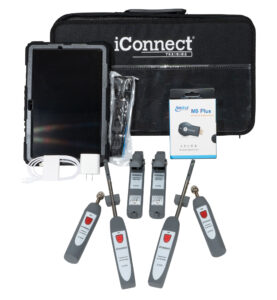As an HVAC instructor, providing students with hands-on, practical experience is essential to their understanding of system performance and troubleshooting. The iConnect Training TU-406C Residential Heat Pump Trainer offers an exceptional teaching tool that allows students to explore real-world HVAC applications. With built-in learning tools like the X13 blower motor, amp draw box, and fault switch box, instructors can design lessons that emphasize critical skills in airflow management, component identification, and system diagnostics.
Here’s a breakdown of how you can use the TU-406C Residential Heat Pump training unit to create impactful lessons for your students:
 1. Lesson on Amp Draw & Airflow Restrictions
1. Lesson on Amp Draw & Airflow Restrictions
Using the TRU Digital Kit’s amp draw measurement feature, instructors can easily create a lesson on how different airflow restrictions affect the blower motor on a residential heat pump. Set up the unit with varying levels of airflow blockage, and have students measure the amp draw of the motor under each condition. This hands-on approach helps students understand the relationship between system restrictions and motor performance, reinforcing the importance of airflow management.
Key Teaching Points:
- How airflow restrictions impact the efficiency of an HVAC system.
- Using amp draw readings to diagnose motor strain.
- Practical understanding of blower motor performance under different conditions.
2. Component Identification & Troubleshooting
The fault switch box with an LED light on the TU-406C provides an excellent opportunity for instructors to teach component identification and troubleshooting. By guiding students through the air handler’s internal components — made easily visible with the help of the LED lights — students can learn to pinpoint problems in the system. Instructors can simulate common faults and have students diagnose and resolve the issues, helping them build troubleshooting skills that are essential in the field.
Key Teaching Points:
- Identifying key components inside an air handler.
- Using visual and electrical diagnostics to troubleshoot faults.
- Understanding the role of each component in system performance.
 3. Lesson on Static Pressure & Airflow Diagnostics
3. Lesson on Static Pressure & Airflow Diagnostics
A great follow-up lesson involves using the digital manometer from the TRU Digital Kit to measure static pressure in both the supply and return ducts. Set up static pressure probes and show students how to properly install them—making sure the tips point into the airflow stream. This lesson helps students understand how static pressure affects airflow through a system and the importance of proper duct design and installation.
Key Teaching Points:
- Proper use and installation of static pressure probes.
- Understanding the role of static pressure in system airflow.
- Measuring and interpreting static pressure data for system diagnostics.
4. Using Digital Tools for Real-Time Monitoring
Another practical lesson for your students involves the integration of digital pyrometers and pressure transducers. Once probes and sensors are connected to the TU-406C, students can use the tablet interface to wirelessly monitor system performance in real time. By analyzing data such as suction and liquid line pressures, superheat, subcooling, and airflow properties, students can gain a comprehensive understanding of how an HVAC system operates under different conditions.
Key Teaching Points:
- Setting up digital sensors for temperature and pressure measurements.
- Analyzing real-time data to understand system performance.
- Calculating key parameters such as superheat, subcooling, and cooling capacity.
5. Advanced Diagnostics and Performance Analysis
For a more advanced lesson, instructors can teach students how to use the TU-406C Residential Heat Pump Trainer’s diagnostic features to perform a full system analysis. Once students have installed pressure and temperature probes and connected the system to a tablet, they can monitor the system’s performance in real-time and even project the data onto a screen for group instruction. This feature allows for group discussions and in-depth analysis of the system’s capacity, airflow, and efficiency, making it a powerful tool for teaching advanced concepts.
Key Teaching Points:
- Understanding CFM (Cubic Feet per Minute) measurements and their impact on system efficiency.
- Interpreting real-time data to diagnose system performance.
- Adjusting system settings based on live diagnostics for optimal performance.
Create Engaging and Effective HVAC Lessons
The iConnect Training TU-406C Residential Heat Pump Trainer is an invaluable tool for HVAC instructors looking to create immersive, hands-on lessons that go beyond theory. By integrating amp draw measurements, static pressure diagnostics, component identification, and digital monitoring, instructors can provide students with a comprehensive understanding of HVAC systems. With the TU-406C, you can engage your students in practical, real-world troubleshooting, preparing them for the challenges they’ll face in the field.
Incorporating these lessons into your curriculum will not only enhance your students’ learning experience but also ensure they graduate with the skills needed to excel in the HVAC industry.